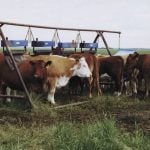London | Reuters — Scotland’s government said on Thursday that a case of bovine spongiform encephalopathy (BSE) had been discovered on a farm in Aberdeenshire, the first in Britain since 2015.
A quarantine area has been put in place around the farm while inspectors try to identify the origin of the disease.
“I have activated the Scottish government’s response plan to protect our valuable farming industry, including establishing a precautionary movement ban being placed on the farm,” Scotland’s farming minister, Fergus Ewing, said in a statement.
Read Also

U.S. livestock: Chicago cattle futures climb on post-Thanksgiving trade
Chicago | Reuters – Chicago Mercantile Exchange’s live and feeder cattle futures ticked up on Friday in a day of…
The infected animal did not enter the food chain and food safety body Food Standards Scotland said there was no risk to human health as a result of the isolated case.
BSE was first detected in Britain in the late 1980s, spreading from there to other parts of Europe and ravaging cattle herds until the early 2000s. It has been linked to the brain-wasting Creutzfeldt-Jakob disease in humans.
World Organization for Animal Health (OIE) data show that the two most recent cases in Britain were in 2015.
“The epidemic of bovine spongiform encephalopathy in cattle in the UK is largely over but there is still the odd detected case,” said Matthew Baylis, chair of veterinary epidemiology at the University of Liverpool.
He said it was too early to say if the case was significant.
“It is described as ‘classical BSE’, like the vast majority of cases we have seen in the UK. This form of BSE is acquired by cattle from BSE-contaminated food,” Baylis said.
“At this stage, we need to know if it was a very old animal, infected long ago, or if it is younger and there is still an active source of infection on the farm, such as a contaminated feed bin.”
Scotland had been classified by the OIE as a zone with a negligible risk of BSE, a status it may now lose. England and Wales have a higher “controlled risk” classification.
“Whilst we lose our negligible risk status, it is not unexpected to see a new case and demonstrates the efficacy of the surveillance measures in place,” Andrew McCornick, president of NFU Scotland, said.
“This simply brings us back in line with the rest of Great Britain, reverting back to where we were 18 months ago.”
Britain’s beef exports were banned by many countries after the original outbreak and in some cases it took many years before measures were lifted. China only lifted a ban on British beef earlier this year.
“Our current export activity is not affected (by this case) and this emphasizes to the world the effective and robust surveillance systems we have in place in the UK,” the British industry- and farmer-funded Agriculture and Horticulture Development Board (AHDB) said in a statement.
— Reporting for Reuters by Andrew MacAskill, Kate Kelland and Nigel Hunt.















